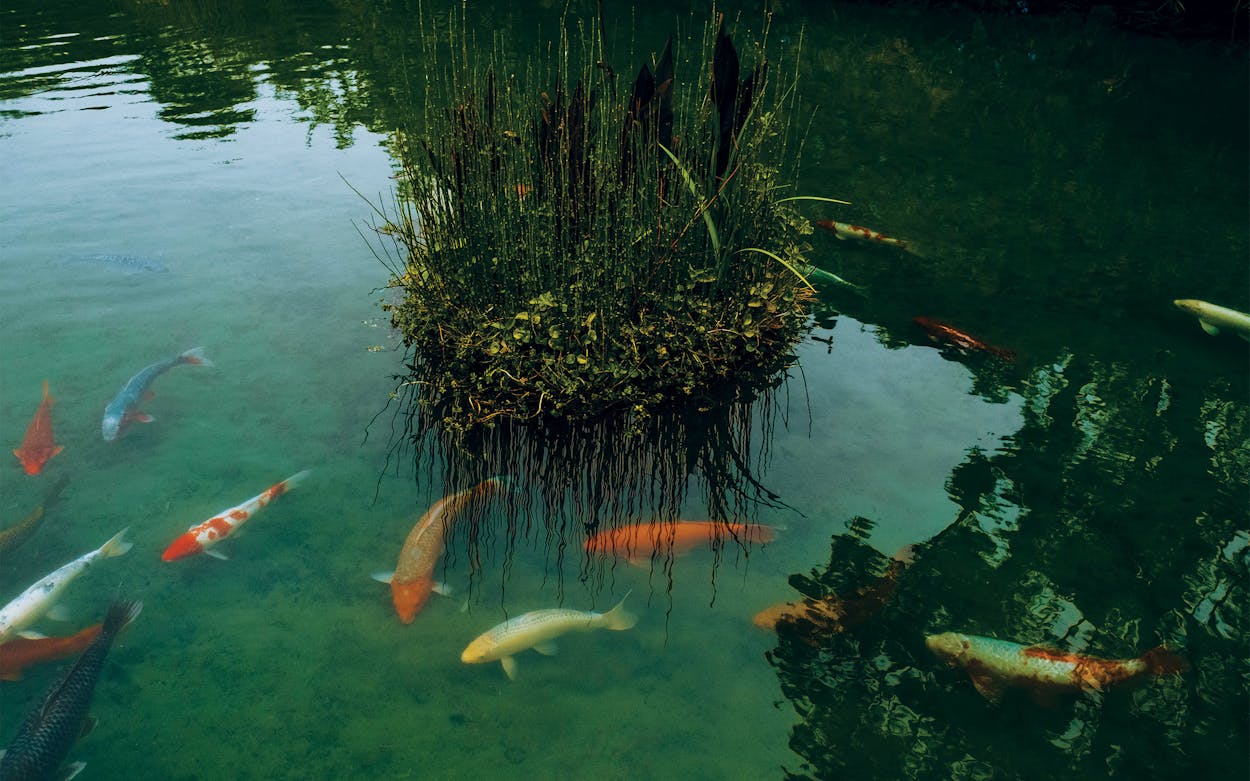As with any kind of garden, successfully installing a Japanese-inspired one here in Texas requires a certain consideration for what works in your zone. Take moss, for example: it’s a popular feature in Japan, but you’re not likely to grow it with great success in many parts of our state. However, you can achieve a similar effect with other plants that thrive in our growing areas. “For us, Asian jasmine works pretty well: we can trim it down and keep it like a carpet,” says Nick Esthus, the horticulture manager at the Fort Worth Botanic Garden’s Japanese Garden, one of the most traditional in the state. “Another good ground plane would be sasa bamboo. It’s ground cover, so it’s only going to get maybe two feet high, but you can trim it to keep it shorter.”
Below, Esthus shares other tips for emulating Japanese gardens in Texas backyards.
Don’t take the concept too literally
“When people in Japan made their gardens, they just used the material that was around them,” Esthus says. “It’s sort of the same thing: you don’t have to use Japanese plants to have a Japanese garden. You want to use plants that are going to work.”
For example, if you like the look of the short, sculptural shrubs you see in Japanese gardens—trimmed in a technique known as karikomi, they often resemble mossy boulders or floating clouds—it’s okay to forgo the traditional azalea bush in favor of a hardier Texas variety. “Probably my favorite for this part of the country is dwarf yaupon holly,” Esthus says. “I mean, it’s a standard garden plant, but there’s a reason for that: they do really well here, they can take the hot heat, and they’re a native plant.” He also recommends boxwood and Korean (wintergreen) boxwood, adding that any Korean varieties of shrubs will better “handle the arctic blasts we sometimes get.” Plant one, and shape it however you please.
Don’t skimp on green
“Green is the essential color,” Esthus says. “The whole idea is to get people to think that they’re in nature.” A good place to start is adding verdant ground cover and the types of shrubs Esthus suggests above. But, tempting as it may be, beware of bringing in standard bamboo. Sure, it will grow quickly (as it did at the Fort Worth Botanic Garden postfreeze, after Esthus and his colleagues cut the struggling stalks back down to the ground). But therein lies the problem: “It really develops a pretty gnarly root system that can have some severe impacts on not only your garden, but your neighbor’s.” In other words, bamboo can be an aggressive spreader—and there’s nothing peaceful about trying to rein it in.
Add evergreen elements, too
Esthus says there’s good reason the pine tree, which doesn’t lose its leaves in winter, is a staple in Japanese gardens. “They’re a symbol of longevity and endurance: being evergreen, they’re ever-present.” He recommends opting for Japanese black pines or Austrian pines, and pruning them once or twice a year in order to “keep them in scale of the garden. And in doing so, that’s where you get to see the cool zigzaggy branches, or what we call ramified branches.”
Incorporate stone and water
Together with greenery, rocks and water make up the Japanese garden design trifecta. “Now, not all Japanese gardens have them, but those are the three most common elements that you’re going to find,” Esthus says. He points out that you don’t have to use actual water, either: a winding garden path might symbolize a flowing river, for instance. But you do want to limit your use of color—particularly what he refers to as “big, flashy annual beds”—throughout. “That’s very much a Western-centric, European-centric idea of gardening, which is fine,” he says. “It’s just different.”
Think beyond stereotypes
You don’t have to add a cherry tree. “The thing about cherry trees is that they get pretty big and they don’t really fit in gardens,” says Esthus. “Where you typically see them are parks and big estate grounds.” If a flowering tree is what you’re after, he says, “There’s a Texas whitebud that has white flowers that does pretty well.”
You might also be tempted to refer to your new refuge as a “Zen garden,” but Esthus says that’s not necessarily what you’re creating. “If it’s at a Zen temple, that would, I guess, make it a Zen garden.” But Zen is a school of Buddhism, not an aesthetic.
Embrace a natural look—but keep it tidy
“As garden builders or garden artists, we’re inspired by nature,” Esthus says. “So there would be more asymmetry.” But don’t use the idea of thoughtful imperfection as a pass for getting lazy: “The maintenance of it is really what makes it a garden.” Remove leaf litter, trim shrubs as needed, and nurture what you plant. “We want to take the best parts of nature and forget about the worst parts of it,” Esthus says. Perhaps another way to think about it—declutter and cultivate a beautiful garden; declutter and cultivate a beautiful mind.
- More About:
- Style & Design
- Fort Worth








